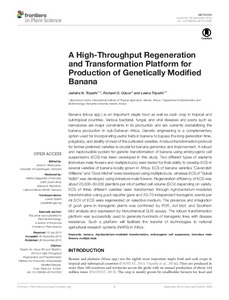| dc.contributor.author | Tripathi, J.N. |
| dc.contributor.author | Oduor, R.O. |
| dc.contributor.author | Tripathi, L. |
| dc.date.accessioned | 2019-12-04T11:03:40Z |
| dc.date.available | 2019-12-04T11:03:40Z |
| dc.date.issued | 2015-11-26 |
| dc.identifier.citation | Tripathi, J.N., Oduor, R.O. & Tripathi, L. (2015). A high-throughput regeneration and transformation platform for production of genetically modified banana. Frontiers in Plant Science, 66:1025 |
| dc.identifier.issn | 1664-462X |
| dc.identifier.uri | https://hdl.handle.net/20.500.12478/1185 |
| dc.description | Published online: 2015 Nov 26 |
| dc.description.abstract | Banana (Musa spp.) is an important staple food as well as cash crop in tropical and subtropical countries. Various bacterial, fungal, and viral diseases and pests such as nematodes are major constraints in its production and are currently destabilizing the banana production in sub-Saharan Africa. Genetic engineering is a complementary option used for incorporating useful traits in banana to bypass the long generation time, polyploidy, and sterility of most of the cultivated varieties. A robust transformation protocol for farmer preferred varieties is crucial for banana genomics and improvement. A robust and reproducible system for genetic transformation of banana using embryogenic cell suspensions (ECS) has been developed in this study. Two different types of explants (immature male flowers and multiple buds) were tested for their ability to develop ECS in several varieties of banana locally grown in Africa. ECS of banana varieties “Cavendish Williams” and “Gros Michel” were developed using multiple buds, whereas ECS of “Sukali Ndiizi” was developed using immature male flowers. Regeneration efficiency of ECS was about 20,000–50,000 plantlets per ml of settled cell volume (SCV) depending on variety. ECS of three different varieties were transformed through Agrobacterium-mediated transformation using gusA reporter gene and 20–70 independent transgenic events per ml SCV of ECS were regenerated on selective medium. The presence and integration of gusA gene in transgenic plants was confirmed by PCR, dot blot, and Southern blot analysis and expression by histochemical GUS assays. The robust transformation platform was successfully used to generate hundreds of transgenic lines with disease resistance. Such a platform will facilitate the transfer of technologies to national agricultural research systems (NARS) in Africa. |
| dc.format.extent | 1-13 |
| dc.language.iso | en |
| dc.subject | Bananas |
| dc.subject | Dna |
| dc.subject | Pest Resistance |
| dc.subject | Agrobacterium |
| dc.title | A high-throughput regeneration and transformation platform for production of genetically modified banana |
| dc.type | Journal Article |
| dc.description.version | Peer Review |
| cg.contributor.crp | Roots, Tubers and Bananas |
| cg.contributor.affiliation | International Institute of Tropical Agriculture |
| cg.contributor.affiliation | Kenyatta University |
| cg.coverage.region | Africa |
| cg.coverage.region | East Africa |
| cg.coverage.country | Kenya |
| cg.coverage.country | Uganda |
| cg.isijournal | ISI Journal |
| cg.authorship.types | CGIAR and developing country institute |
| cg.iitasubject | Banana |
| cg.journal | Frontiers in Plant Science |
| cg.howpublished | Formally Published |
| cg.accessibilitystatus | Open Access |
| local.dspaceid | 78380 |
| cg.targetaudience | Scientists |
| cg.identifier.doi | https://dx.doi.org/10.3389/fpls.2015.01025 |

